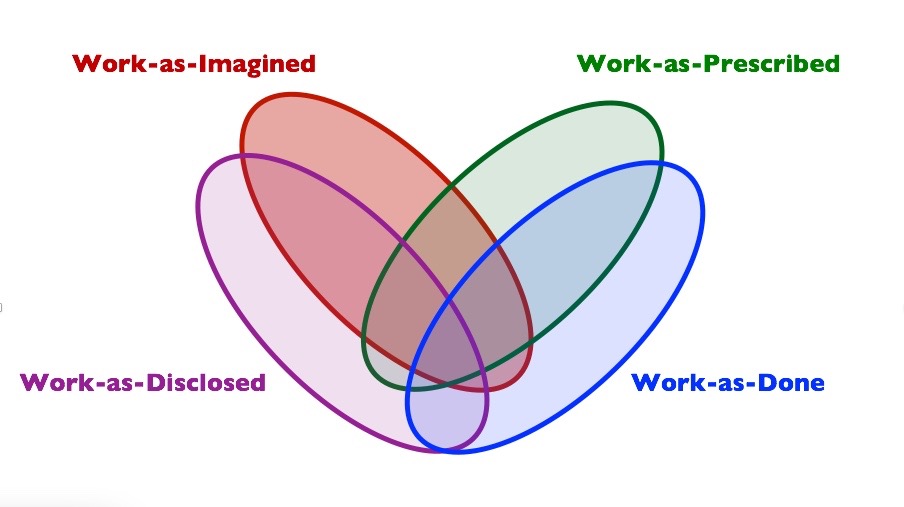How people think that work is done and how work is actually done are two different things. This observation is ... decades old ... arguably [as far back as] the 1940s in analysis of aircraft accidents. The Varieties of Human Work. Steven Shorrock. 2016. site ![]()

Four broad categories in the varieties of work all of which partially overlap, but none of which completely overlap: work-as-imagined, work-as-prescribed, work-as-disclosed, work-as-done.
.
We can change our systems more effectively if we design for the full complexity of work by humans. Learning from incidents is a powerful tool for discovering that full complexity.
The diagram on its own communicates so much with just a moment of study. We have four categories, each a different kind of work. They overlap, but not completely.
Recognizing these distinctions, that what we imagine work to be, what we disclose when talking to people about our work, what gets prescribed in the rules or the job description, and how it's actually done are all completely different things.
There is enough overlap to be interesting, but enough distiction to also be interesting.
Having come out of the design practice myself, everything about design is in the work-as-imagined space.
Most of business is in a delusion between work-as-imagined and -as-prescribed. Maybe we know that we don't really know how the business is actually done, but we don't make any rules that really honor how work is actually done. And certainly, it's all challenged by how people can talk about it.
I've been reflecting on work-as-disclosed recently. What we allow ourselves to disclose and what we keep to ourselves creates barriers to designing our policies and source code so they remain well-calibrated to realities of work-as-done.
When leaders are communicating priorities to the rank and file, they have a duty to conceal insider information they know about the current financial state, for example if some acquisition is in the works.
A manager may come to know something very private about members of their staff which must be kept in confidence.
There's all sorts of things that constrain what leaders can disclose. Even the prioritization about what's most important for the company, or why it is important is filtered by constraints on what the leader can disclose.
And then the other way around, everybody down in the trenches wants to tell their boss a slightly rosier story than what's really going on. And their boss and their boss. And so by the time the news from the trenches gets all the way to the leaders, it's been filtered by the telephone game and made rosier all the way along. For a humorous and crass illustration of pattern, see SNAFU Principle.
The end result of both of these forces is that the top of the organization and the bottom of the organization can't really communicate. Even if we can sit in the same room and have a conversation.
Work-as-disclosed ends up being a real barrier to getting a design that's well connected to reality.
Business decisions, especially in software, are frequently design decisions.
.
See also Audi R8 or Chicken Bus?
Work-as-disclosed is given a fuller treatment, with links to other varieties of work. site ![]()
Exploration of Shorrock's site rewards further study.
Seven archetypes related to the Varieties of Human Work:
Nine proxies for work-as-done are outlined are: